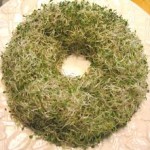I was inspired to write this post by the work of Kim Douillard and Kevin Hodgson in a project called “Slices of Life”.
I was especially struck by Kevin’s photos here (and I am avidly awaiting Kim’s). In Kevin’s night picture, however, I found myself wondering about what I could not see just as much as by what I could see. Having taken night photos before, I also thought about how limiting the camera is as it tries to record the fullness that the night can seem. I know that is not a fair comparison in many ways, but technology is almost always like that. In other words, in the fair light of day or night, technology reduces, delimits, and otherwise ‘cheapens’ experience. It makes the world more legible, but less wise.
For example, below is a photo of a rectangular platte of ground shot this morning just outside my back door.

What we see has little to do with it means. For one thing, the metaphor of the ‘frame’ makes legible only a very small portion of the available universe. In a way this is exactly what the brain does so very well–it uses an ‘ignorance’ filter. And by ‘ignorance’ I mean that we accent the second syllable. Based upon some idiosyncratic and lifelong evolving algorithm, each of our brains takes from the picture above what it will and ignores the rest. A collander metaphor jumps to mind. Or maybe it actively pays attention to some stuff in favor of other stuff, a pattern bias unique to each of our own sets of experience. Schrodinger’s Cat? Or Maxwell’s Demon?
But our views signify uniquely. Each of us comes to the photo with a different filter. Thinking out loud here, perhaps the metaphor is a loom, a Jacquard loom with a punchcard template (read schema) that weaves the sensorium back and forth. Or as early neuroscientist Charles Sherrington called it “the enchanted loom”. The quote below is the loom in action according to Sherrington as our brain wakes from sleep.
The great topmost sheet of the mass, that where hardly a light had twinkled or moved, becomes now a sparkling field of rhythmic flashing points with trains of traveling sparks hurrying hither and thither. The brain is waking and with it the mind is returning. It is as if the Milky Way entered upon some cosmic dance. Swiftly the head mass becomes an enchanted loom where millions of flashing shuttles weave a dissolving pattern, always a meaningful pattern though never an abiding one; a shifting harmony of subpatterns.
I am not thinking of the kind of loom below as a metaphor although it is cool and tempting.
This weaving of the senses in with the schema we already have in our minds, that’s what I have in…mind. Now, back to the matter at hand, the practical matter of what is seen in the rectangle of ground outside my back door.
First, I see or infer dozens of holes in the ground. Worms, beetles, and other critters are pouring from the warming soil looking for I know not what. Perhaps they are like Mole in The Wind in the Willows. They’ve got spring fever and are saying to themselves, “onion sauce”. The are holing out of the ground and checking out the surface because they can and because they feel the need. Fanciful? Yet the holes are there and my mind weaves in some Kenneth Grahame
Second, I know what the holes signify–soil health. There is much to eat and many to eat it. In a way it is as the hermetic philosophers insisted, “As above, so below.” Another weaving of the loom that contemplates the health of the soil.

Third, it means that spring has sprung. This cliche is reinforced by the ‘frogged’ thrum of peepers in the background ready to move and mate and carry on with the ancient seasonal struggle. And all the other heaves and sighs and blats and tweets of spring. Not to mention the smell and breath of spring, its earth and touch moving in between what I see and hear and what I have seen and heard in sixty years of springs.
The camera’s purpose, like the brain’s, is to limit. An example of this is filtering within apps. I have been playing with two such tools of late: Adobe Shape and Waterlogue.
Here is how Waterlogue uses its “It’s Technical” filter to view the ground above… and so below.

Reminds me of a topographic map without text. In this case the map is both the territory and not the territory, what Vedantic philosophy calls “neti-neti”. This filter is not like the brain’s enchanted loom. It simply renders the photo into something legible. It does not mean anything independent of the brain that views it. Does a photo rendered in a forest by a filter signify if no one is around to view it? Nope.
The other app, Adobe Shape is even more stark in its mapping of filter onto photo. Hard to believe it has the same picture as its source.

Photo filters and apps are more like the chain of punch cards for a jacquard loom than Sherrington’s magical shuttle metaphor. This Adobe Shape filter seems more like a reduction of the original to that of a photomicrograph of…brain tissue, neurons and glia. But, of course, that is what I am ‘weaving into’ the filtered picture. I love the image of my mind shuttling back and forth into what it sees and carrying with it the partial, conjoined datum of the the brain (what it knows past, present,future) and carrying back the sensorium. The gif below does not even begin to approach the speed and complexity of the process, but it begins to point at how meaning might begin to be made.
I return to the original inspiration–overlooked moments. I think that every photo by design is an overlooked moment. Each one has an audience that o’erlooks it. That ‘overlooking’ is the meaning making moment, the time when the brain fills in the blanks or, using Sherrington’s metaphor, uses the enchanted shuttle to weave meaning back and forth. And because there are many possible weavers, any picture can be a nexus for even more complex brocades, quilts, and damasks. Is that what Kevin and Kim are doing. And me, too. We are “flashing shuttles weav[ing] a dissolving pattern, always a meaningful pattern though never an abiding one.” And always there is something overlooked that someone else can weave in or (and this is something I am only now considering) weave out, Penelope-like in the night.
Now what do you see that has been overlooked. I invite you to invoke the Muse, grab the enchanted shuttle and make. We live in a world of connection and construction that is beginning to fit our minds better every day. Carpe neuron!



















